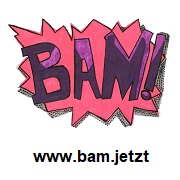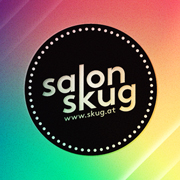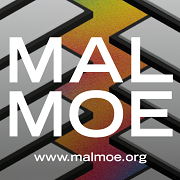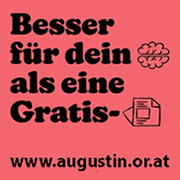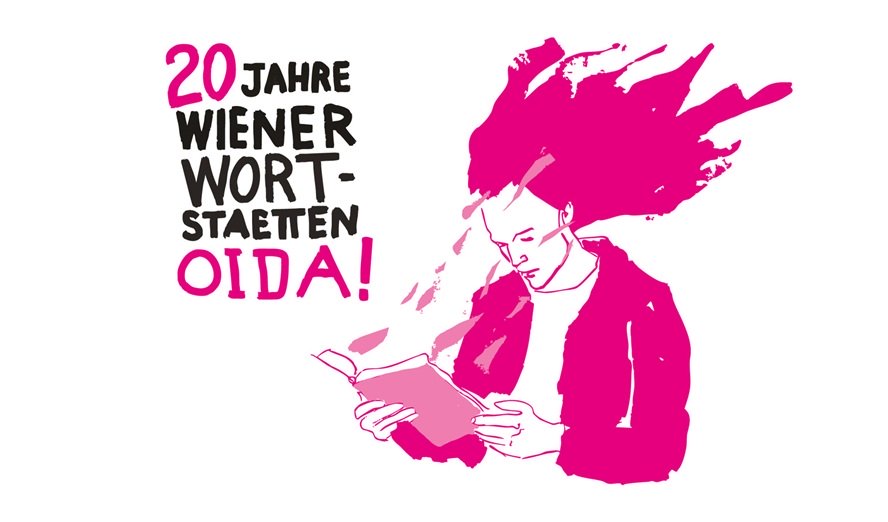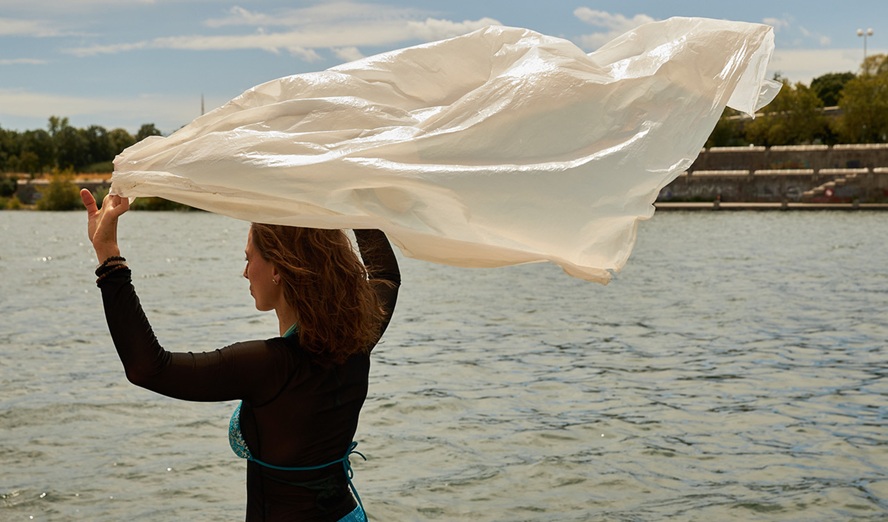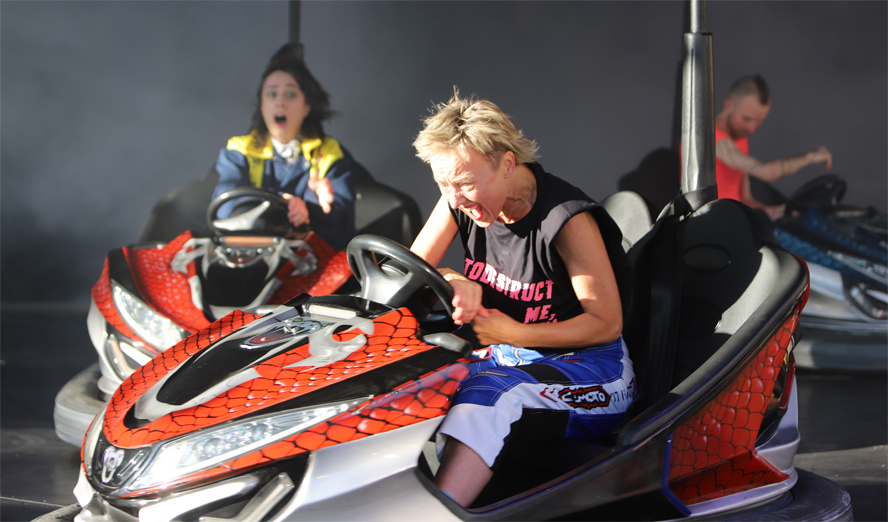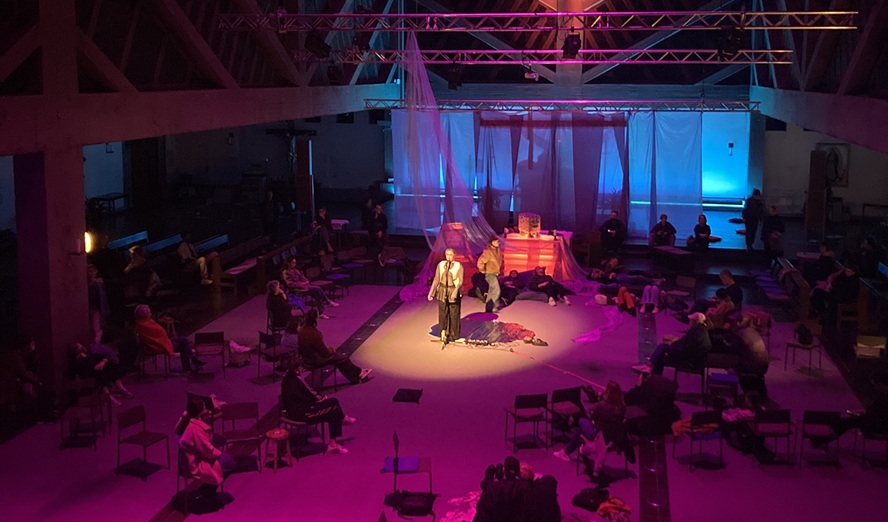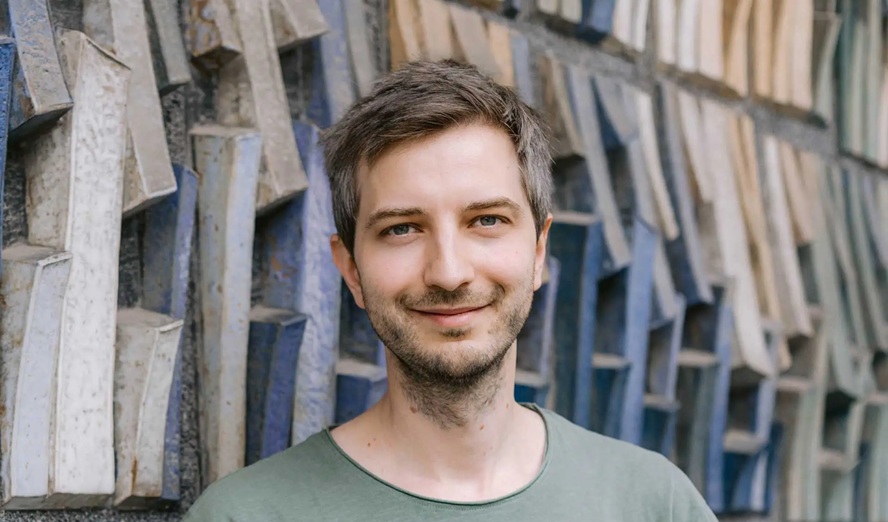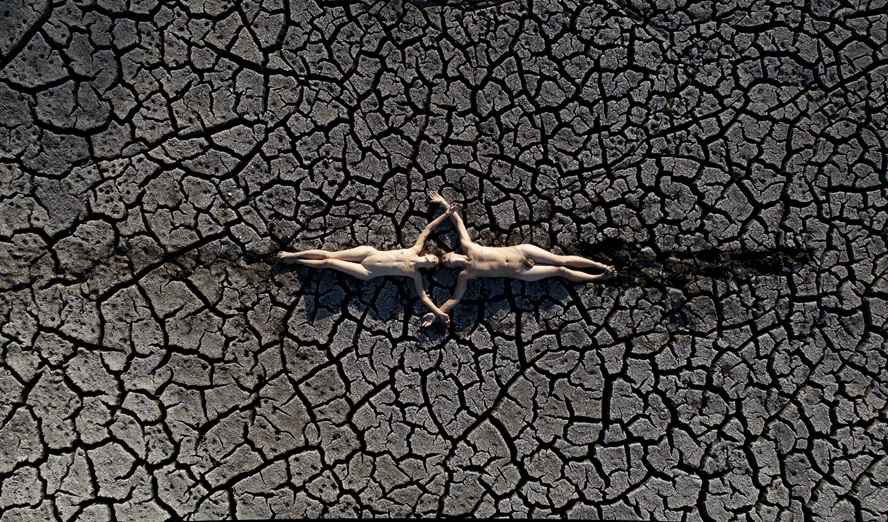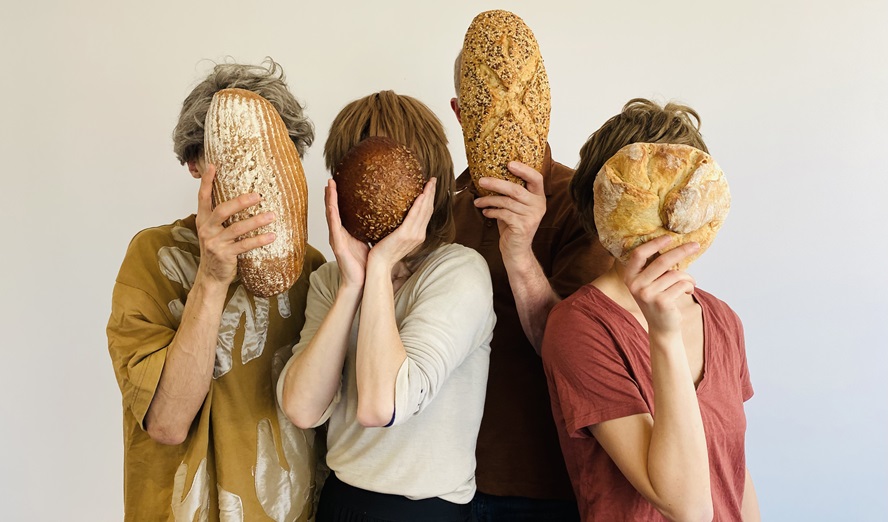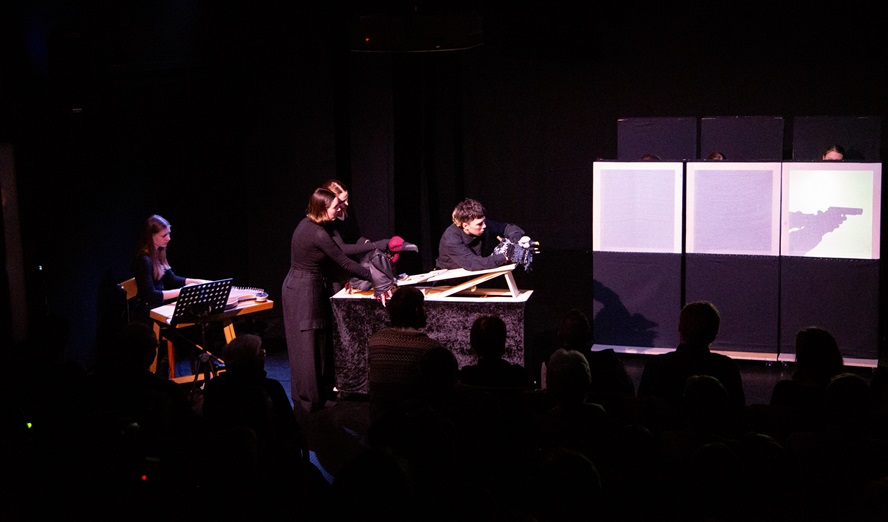The collaboration between utrumque and the performers of Der Betrieb during »The Season of Sound« is grounded in a mutual emphasis on durational practices, exploring repetition and variation. utrumque will create sonic patterns that will interlink with the movement and vocal patterns of the performers. Der Betrieb is an art space in the 15th district in Vienna that is dedicated to durational dance performances. It will be transformed into a musical instrument by utrumque, using its acoustic characteristics, the objects within it, and the people who occupy it. They will all interact to create the music. To explore these unique properties, utrumque augments the performance space with strategically placed loudspeakers and microphones, enabling them to capture and interact with its specificities from deliberately chosen angles. During »The Season of Sound«, utrumque transforms Der Betrieb by introducing resonators made from glass, wood, and metal. These resonators work similarly to loudspeakers, in that they are vibrated by electric transducers, capable of creating rich sonic textures. The resulting sounds are captured using a combination of contact and aerial microphones, which feed the signals into utrumque’s digital systems. This fuses the acoustic environment and utrumque’s digital framework. utrumque will fill the space with audible and inaudible sounds, ranging from the sub-sonic to the ultrasonic. These sounds will be affected by any change in the environment, e.g. a performer or even an audience member moving. This is sometimes directly audible, and the resulting interferences from any change in the environment can also be analyzed to estimate the amount of motion in Der Betrieb. This data becomes a vital input to utrumque’s digital processes, directly influencing the music they compose and perform in response to the environment’s evolving dynamics. For all performances, utrumque will be present to guide the sonic developments and intervene musically. So during the »The Season of Sound«, a former hairdressing salon will be transformed into a musical instrument and the acoustic properties of the objects and people will be developed in the participatory performance showroom Der Betrieb, which is opening its doors again this year. utrumque will be present at all performances to observe the sound as it develops, to guide it and to intervene musically. skug met with utrumque’s Gerhard Eckel and Ludvig Elblaus together with the dancer and artistic director Alexander Gottfarb for an interview on site during rehearsals.
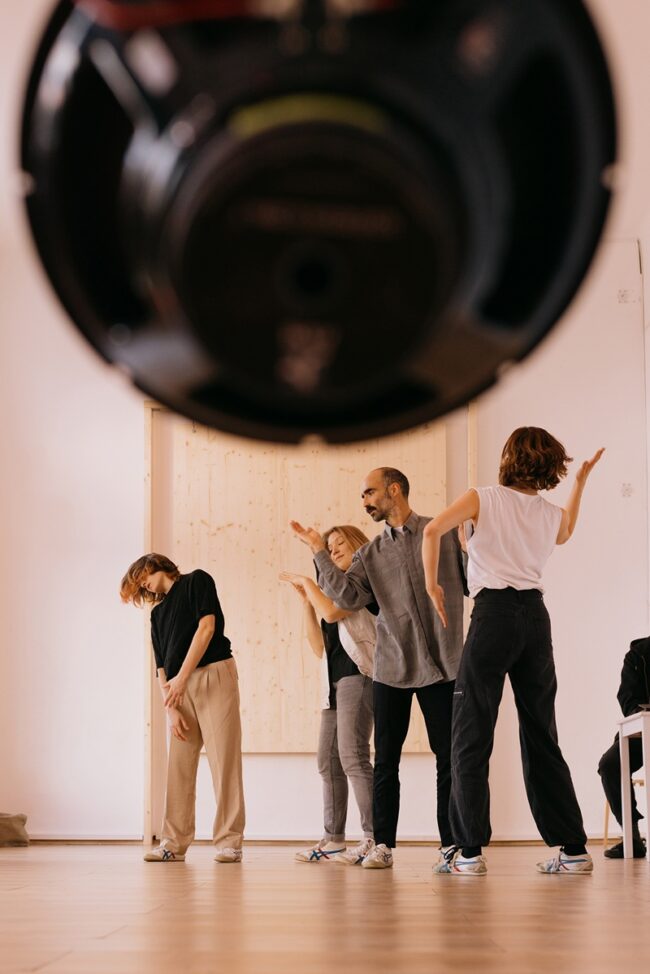
skug: I would like to start our conversation by stating: »We are sitting in a room…«
Ludvig Elblaus: »…different from the one you are sitting in now«.
After quoting the American sound artist Alvin Lucier’s work »I Am Sitting in a Room« from 1969, let’s talk about the idea behind Der Betrieb.
Alexander Gottfarb: We started two and a half years ago, in autumn 2022. It came out of a wish to create a work situation that is sustainable by having longer durations of performances. As a maker, my everyday life is about performing in a space that is accessible to an audience. And we are now in an old hairdresser salon, a space with big windows to the street, you can watch the things we do from outside, and it is possible to enter the space during opening times. When we took over this place, the only thing we changed was that we took away the mirrors and the chairs and repainted everything in white.
To create a kind of White Cube?
Alexander Gottfarb: In a way, so that it functions more in a way of a gallery space or a library of live performance art, being accessible for the public. We have two seasons here, one in Autumn and one in Spring. They are each six to eight weeks long and when we are performing it is always open from Wednesday until Saturday from 2 pm to 7 pm: five hours a day, four days a week. You don’t need an entry ticket, people can come and go as they want. And they can stay as long as they want, five minutes or five hours, it is up to them to decide. It has already been established in a way so that some people really come once a week to see what is going on. They step in on their way home from work and stay for let’s say twenty minutes. Whereas others come and stay a whole Saturday for five hours to experience these durational performances in this place. Anna Nowak has so far done »The Emotional Season« and »The Generation Season«, her work is related to metaphors and comes out of an interest in text and to see how languages and texts are influencing the body and vice versa. In my work, the key notions are repetition and transformation. I work with these aspects in a performance practice that I have been doing for many years and now we have come to the point where we start to include more and more voice. Soon we start the »The Season of Sound« in which Ludvig and Gerhard are included with their work on sound. The durational aspect of their work is one meeting point of our collaboration.
How did you meet each other?
Gerhard Eckel: We have known each other for a long time. Anna and Alex were participating in an artistic research project that I was running at the University of Performing Arts in Graz, at the Institute of Electronic Music and Acoustics (IEM). That project was called »Embodied Generative Music«. The idea was to create a relationship between the bodily movement and the sound that is produced through the movement. It was mainly based on motion capture technologies. On a very detailed level we could follow the bodily movements and use that to create the sounds. This offers all kinds of interesting questions, for example because the sound is produced by the movement that usually follows the sound. Technologically it was complex because you need many cameras in the room and many markers on the body.
Alexander Gottfarb: It was technically heavy, with a lot of set up, with infra-red cameras and so on. Afterwards we did two collaborations, »Every move a sound« and »On traces«, where we scaled down the set-up but used the same technology and channelled it towards an artistic work rather than a research work.
Gerhard Eckel: There is an interesting link between these questions of motion detection. Ludvig was also working with those systems, and we talked about this problem of needing all those cameras. That was one of the starting points of our collaboration as utrumque.
Ludvig Elblaus: The monumental scale in terms of technical know-how and money, the logistics of gaining access to rehearsal time and calibrating these systems, we both had the experience it was not always worth the trouble somehow. So we were looking for a more human-scale and human sort of way of what we want to subject the people moving to and what kind of situation we want to create. We come from a trajectory where we try to situate ourselves relationally to those we invite, both as collaborators and as an audience. Where and how do we want to spend our time? How do we relate to the people who are in the room with us?
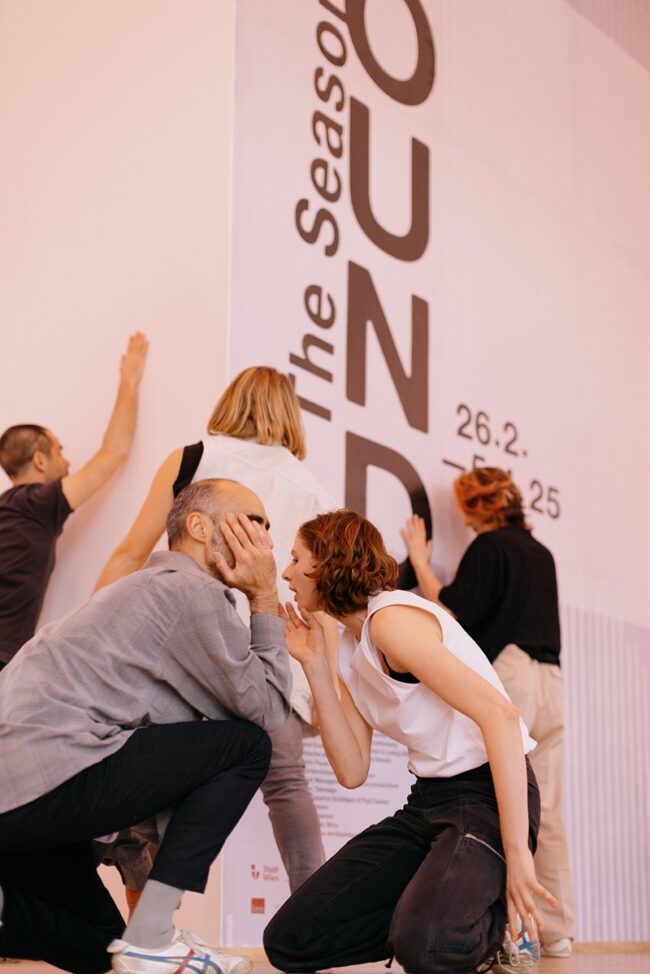
Would you like the term laboratory for the performance space Der Betrieb?
Alexander Gottfarb: It is a performance space where ongoing performances are happening. We can relocate the role of contemporary dance and contemporary music and how we come across it in our society. I think it is good to use the same terminologies as for things happening in theatre because it is also about understanding the value of the time spent together. Can we place artistic activities in a more open societal frame such as this space rather than close ourselves off to a traditional theatre setup and the staticness that comes with it? Referring back to the very beginning of this work, how it all came about. It is about imagining our cities to look different: what if every second space on street level would host for example a public library, or a Ping-Pong place, a common workplace that is provided by the city. Or a place that is dedicated to live music with rotational schemes and you can walk in for free. How could we integrate art in our society differently?
You highlight with the name Der Betrieb that it is first and foremost a working place. And every visitor so to say changes the performance work that is going on here.
Alexander Gottfarb: Absolutely. We had in the past a format called »Your season – In search of a common season«. That season was really about participation with a more detailed score of how you could participate. In this »The Season of Sound«, everyone who is coming in is of course already participating through their presence as you were saying. But this time we are not asking them to join the dance or to turn a button for the sound control. But what they can do of course is to change their position and listen and use all their senses. And when you step through the door you are already on the performance ground. There is no way to escape it. We see all these very different reactions. There are some people who need to land next to the entrance door before they dare to engage whereas other people immediately feel free to walk through the space to the corners and lay down, they angle their head to listen to the sound waves. You have all these different options. Our main rule is that we allow everything to happen as long as it doesn’t challenge the continuity of what we are doing. As long as it doesn’t disturb us in the long term – and again, time is our ally – we let them do for example a group dance because it will stop eventually.
Ludvig Elblaus: And we have work to do anyways.
Alexander Gottfarb: So if someone joins for a while it is okay with us, we have so many hours to do the overall thing we do. Usually, we have a host person who is explaining what we are doing, or we are mediating it with a score card that is adapted for each season. With »Your season – In search of the common season« we had a long list of how exactly one could participate. We probably will have a score card for »The Season of Sound« when we open on 26 February so that people will get more sensitive to our spacing and our sounds. I remember now a project of utrumque where I had to connect and disconnect a cable from a microphone, so I appeared twice on stage. The fascination from my side was that we were playing with the natural feedback happening with a microphone and a speaker that is specific for each room. How to find a way to play with these parameters of the space. In terms of Der Betrieb I was wondering how we could build a space where the mass of the body – and coming back to the topic of an audience, the mass of any person – is important here. You could see it as a way of democratizing the space: where you position yourself here will have an impact on how this space sounds. That idea is very appealing to me. So to get rid of all the complicated technique and just see that, there are already frequencies and waves in here, and we are actually touching each other with that. It is a very basic phenomena that is beautiful to explore.
So you try to use a whole room as a musical instrument. I am interested now, how do you get to know a room so you can use it as an instrument?
Ludvig Elblaus: We have been to previous seasons of Der Betrieb. And the three of us had already done exploratory work that one could probably consider laboratory work in different studios in Graz. We were basically trying to find a language of understanding these processes and how they are situated in our practices. It is about bringing the experience of having charged many rooms already with musical capabilities to this place. The particular relationship to the city is very interesting. And people who come in change the space with their mass and we are also making these visual openings of the glass windows acoustically porous by having these transducers so that sounds of the city can seep in and we can carefully and quietly put some audio back on the street. This site has softer and harder boundaries and playing with that is important for us. The directing of the intentions of others is also an important component in this work. The rigidity of a theatre house with its structures like: you have to sit here, so are supposed to look there. It is not as clear what to listen to, what you are allowed to watch here. We will explore how we can share the shaping of directing attention by moving sounds and bodies.
Gerhard Eckel: We create a multiplicity of possibilities. The attention can wander. You can even watch a car outside.
Ludvig Elblaus: And we somehow need to show up and perform in a sense that we have to perform the listening. To guide the behaviour of others. Moving into a sound installation and seeing a person like Gerhard sitting in a corner and being super concentrated with listening changes how everyone else behaves in the room. That’s an interrelational component of a somehow staged performance.
Alexander Gottfarb: One of our main principles is also that we understand this space as a place of practicing being together. For that to happen it needs to be a little bit unstable because otherwise if it is too settled like in a common theatre there are certain codes. In here there is an uncertainty and variety of how we can be together. How are we and how is the material surrounding us resonating?
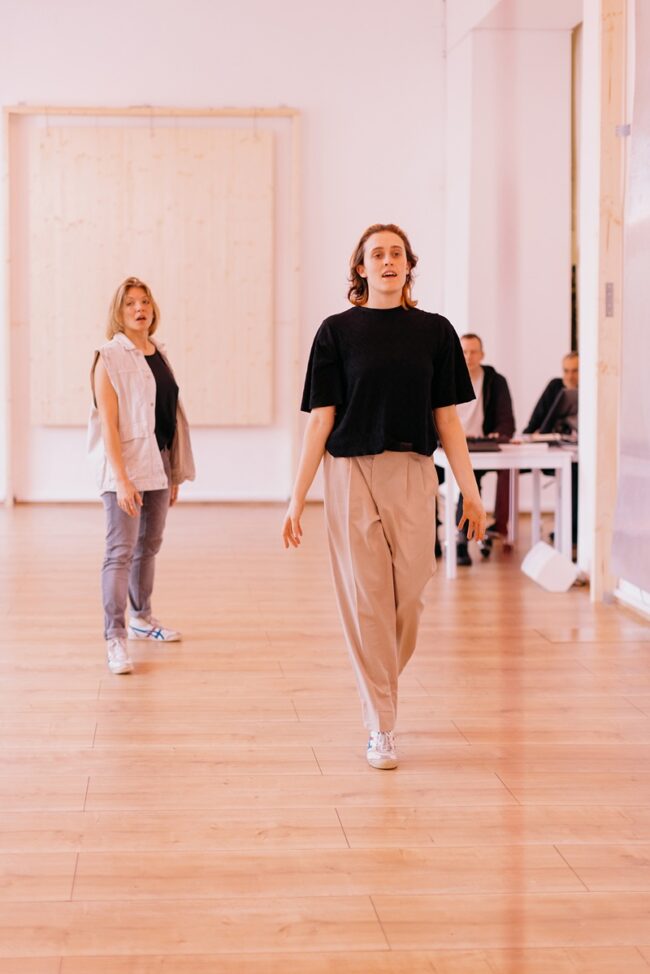
Recently I read in the book called »Stoffwechselpolitik« by Simon Schaupp, stating that we should not forget that we are human beings first, not human doings – always trying to be busy with something, intoxicated with neoliberal compulsions.
Gerhard Eckel: We consider a room as our partner, our instrument, and now we have reached a new level here by implementing or using mechanical structures – like the windows – that can sense and produce sounds.
Ludvig Elblaus: It think it has something poetic to it, using glass as well as wood and metal as membranes. We want to find new ways for us to disseminate sound, that brings us away from more traditional electro-acoustic loudspeaker setups. First of all, here we don’t have a spatial symmetry. In the last years we have been working with traditional musical objects like a double bass and a snare drum that we electrified with contact microphones but indeed this project now is more sculptural and on a grander scale.
These objects, these resonators made from glass, wood and metal on the wall even remind me of Minimal Art.
Gerhard Eckel: I think it is particularly appealing for people who come from our domain, where we are always surrounded by loudspeakers that all point into our face. We enjoy that those objects first of all don’t look like loudspeakers but also sound completely different. They have a character, each material is very particular. We are trying to make use of that.
Ludvig Elblaus: These objects sound different, they also project very differently. A loudspeaker is designed to project forward, you are not supposed to listen to it from any other direction. An instrument like a violin or a double bass radiates the sound in a much more particular way, it is more varied, more pleasurable. These objects also signal and actuate another relationship to the space.
Gerhard Eckel: We are so used to sound being reproduced by loudspeakers that in a certain way we consider them as transparent, but they are not.
Alexander Gottfarb: In the same sense that a loudspeaker has a membrane, these surfaces are like the membranes of speakers.
Gerhard Eckel: We use contact microphones to pick up the vibrations of the objects. We can establish a relationship between the shop window and a metal plate for example inside the room on the opposite side. Our practice consists of considering the space or the instrument, as the vehicle that produces the sound in the first place. The whole space is creating the sound, and you are part of that sound producing machine. If you move, you change the sound of the space, of the instrument.
Alexander Gottfarb (pointing to a small object hanging from the ceiling): Talking about the mass of the body in the space, this is an ultrasound microphone which is a big player even though it is quite small.
Ludvig Elblaus: We are doing experiments where we try to introduce the mass of the body into feedback systems. Often it is about recirculation of audio, and if you put an object in the way of the sound you can shape it. We have to take into account the relationship between the frequency band that we like to listen to and the size of our bodies, as any particular frequency has a wave length that has a certain size in a room. Audio of course can be very high and low frequency, and with this kind of »showering device« up there we can extend our audio practice into ranges that we might not hear, but with these very short wavelengths give us a spatial resolution of how our bodies can dampen the sounds to a much finer degree.
So a person in the room is subjected to audible and inaudible sounds…
Gerhard Eckel: So it is possible that you as an audience member can modulate the soundscape in the room just by moving your hand.
Ludvig Elblaus: We interact physically with sound just by moving our mass through space.
Alexander Gottfarb: It is a way of understanding relations, and now I should also mention Clelia Colonna who is working with different vowels and the resonances inside the different places of the body. We are also looking at where inside bodies resonance can take place. The inner bodily and the outer bodily logics are melting together. It is about affection and vibration.
Gerhard Eckel: And the microphones in this room function similar to a hand that you put on a glass window to actually feel the vibration of a truck that is passing by outside. It is the same tactile directness that for example vocal sounds find their way to the computer and come back as sounds through the wooden plate.
Alexander Gottfarb: A maybe naive but direct question that one can carry, entering as an audience member: How does it feel to be touched by sound? On a physical but also on a metaphorical level.
During the opening hours you will be present in the room. What is your exact role during these durational performances?
Gerhard Eckel: Listening is a very important part. We are part of the moment and the situation and try to subtly modulate it.
Ludvig Elblaus: It is an act of curation by picking sounds and making them available, interacting with the dancers.
Alexander Gottfarb: This question will be answered quite differently in the beginning, middle and towards the end of the season. In my understanding: If you would switch everything on, there would be a lot of acoustic information in here. So it is about filtering out and choosing something, directing the listening by turning knobs.
Ludvig Elblaus: We composed structures sympathetic to the concerns of Der Betrieb.
Alexander Gottfarb: Shall we switch the sound system on to show you an example?
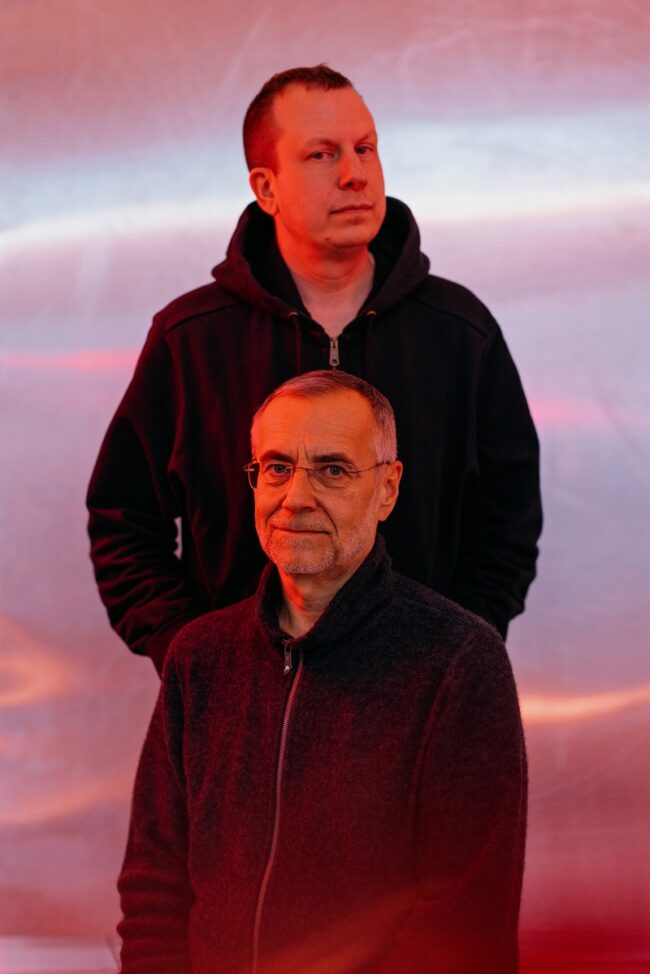
(After a short performance of a repetitive, slow dance from one side of the room to the other by Alexander Gottfarb and repetitive and slowly changing sounds by utrumque the interview is continued.) An interesting experience, watching your activities and also closing my eyes, was that when I closed my eyes, I could not really understand the size of the room anymore…
Ludvig Elblaus: A few decades ago, when people in a studio wanted to simulate a big room, they sent audio through a plate, that was one of the reverberation techniques in the last century. Many music recording studios had a separate room for this. By utilizing these techniques, we are messing around a little bit with regular perceptions of room acoustics.
Alexander Gottfarb: The basic principle of what we are doing in the physical practice is that everything you are doing has to be repeated and it is gradually transformed over time. So on one hand, we are paying attention to the changes between the repetitions since nothing can ever happen the same way twice. On the other hand, we are adding a certain direction in order to moderate the wish for a dialog between the movements. Before I start, I choose my focus and that already directs the main attention of the repetition. Since it is impossible to stay in control of the whole machinery, I need to pick and choose. That guides and influences the pace and the transformation and the speed of the movement patterns. The principle of the practice is that you have to repeat what you are doing. You can only loose an element on the way if you decide it is part of the pattern.
Gerhard Eckel: The durational frame was very appealing to us, because when we develop our music, we can play without end. And one problem that occurs is: How are we going to show this somewhere?
Ludvig Elblaus: Even a four-hour concert is something that you have to fight for – and it is still reductive. So it is now a tremendous opportunity to be able to stay with it and tune in to the material.
The movements even look like a secret ritual in a way, a lot of rituals work with repetitive patterns.
Alexander Gottfarb: It is part of our artistic practice that we are working with repetition, and it affects the mind and the brain by this very specific concentration. You can trust repetition, it is a rewarding place to be. If we speak about theatre dramaturgy, for the audience the combination of surprise and recognition is important. You probably won’t see sudden changes here in this performance space and therefore it is really a safe space to relax.
Ludvig Elblaus: Just repeating something mechanically is not the point. It is about being consumed by your own experience by being attentive. Complete attention and concentration for a long period relating to what is going on around you. We try to direct the people to pay attention to details. We want to provide a state of relaxation. When Gerhard and I started to work together we wanted to explore different aspects of feedback sound and how it relates to bodies. Actually, we had a long list of fifteen to twenty things that we wanted to work through, and that was about seven years ago. And we still work on the first thing. To find a name or a label to put on our collaboration, we picked utrumque, having this eternal folding of yet another thing and another thing and so on felt fitting. That has been our mode of production and mode of relating. If we are not commissioned to do it – like we can do here in Der Betrieb – we would do it anyway somehow.
To follow the eternal thought of sound: What are fields of other disciplines that inspire your audio research?
Ludvig Elblaus: Physical modeling. Dynamical systems…
Gerhard Eckel: Cybernetics, that encompasses most of the aspects we are dealing with. And our work is very empirical. How do we perceive the world, how do we make sense? We can never really predict what is going to happen, there are forces that are emerging that you cannot predict.
Ludvig Elblaus: How do we see our agencies, our authorship in the world? Do you want to decide what is going to happen? Is it more a being-with, are you sort of »dancing with the world« to co-create the understanding of what is going on?
Gerhard Eckel: Our duo offers an ideal dynamic because it necessitates communication and negotiation in everything we do. We exchange the principles behind our ideas and refine them together. Ethics naturally emerge from this process. Our foundation is built on shared ethical values rather than a common aesthetic.
This interview was first published in a shorter version at mica – music austria.
»The Season of Sound«, February 26th to April 5th, 2025, Wednesday to Saturday, 02.00–07.00 pm, Der Betrieb: Vogelweidplatz 13, 1150 Vienna, Admission free
Artistic direction: Alexander Gottfarb; live music and composition: Gerhard Eckel and Ludvig Elblaus (utrumque); choreography and dance: Stella Covi, Alexander Gottfarb, Jolyane Langlois, Raul Maia and Lena Schattenberg, costumes: Karin Pauer, production and management: mollusca productions


